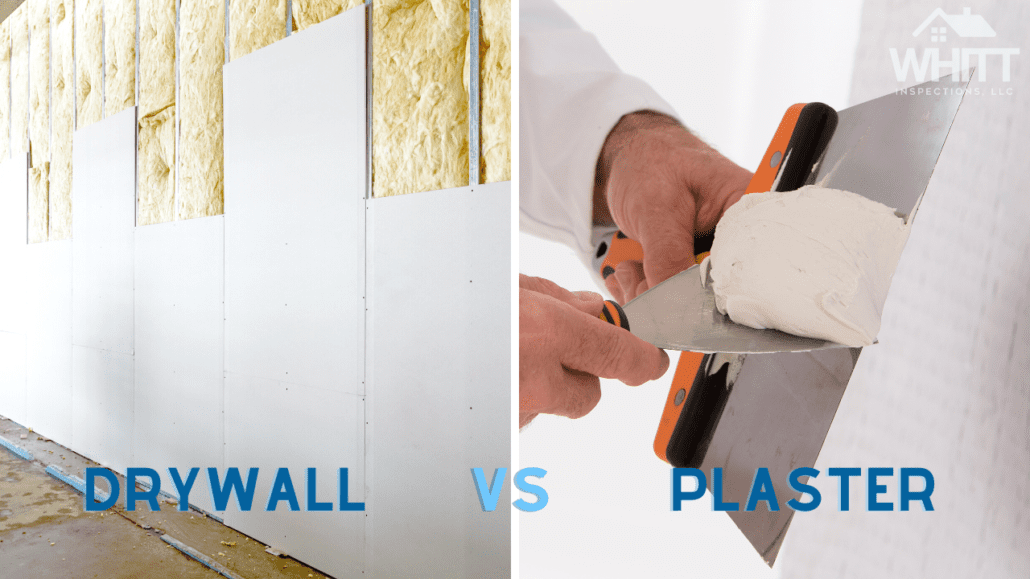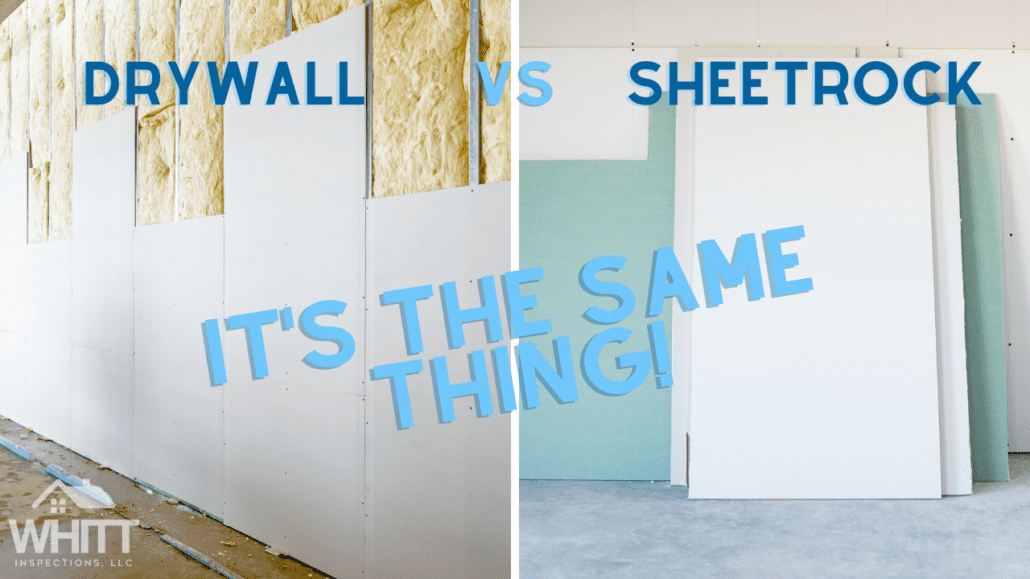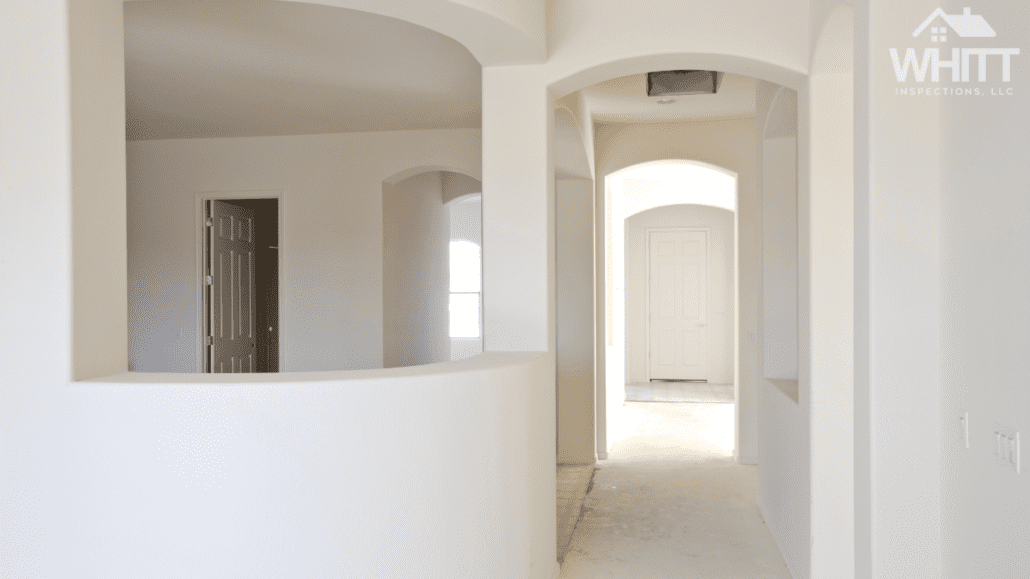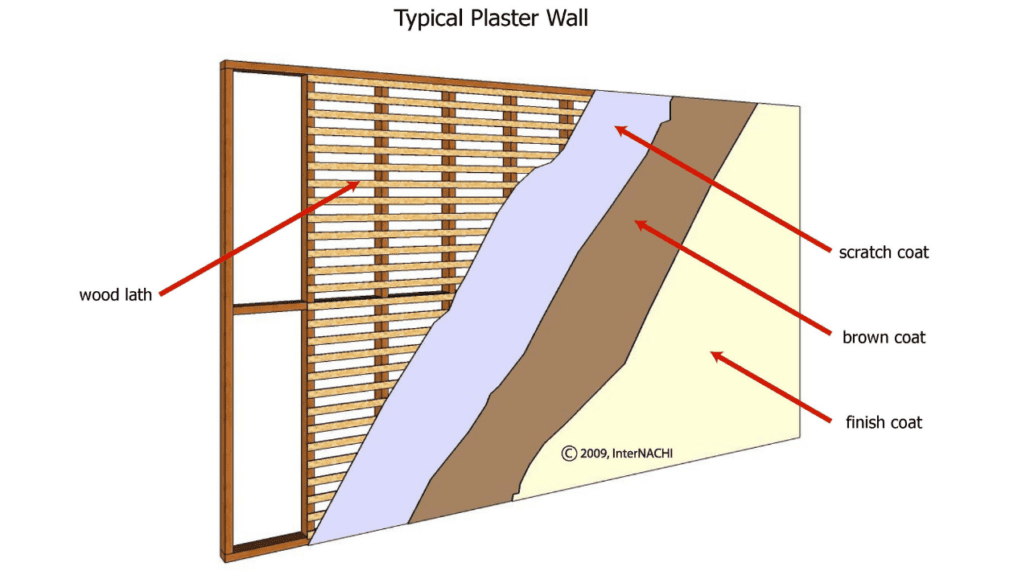I Have Plaster Walls in My House — Now what? A Guide on How To Handle Plaster Walls
While inspecting homes across the Central Florida area, we run into various versions of this question all of the time: What’s the difference between plaster walls/ceilings and drywall?
If you have an older home, or are considering purchasing one, you might need to learn how to handle plaster walls.
Drywall, on the other hand, is easier to deal with and probably more familiar to you. Most new homes these days are made with drywall, and you can easily find supplies at your local hardware supply store. Plus, there are plenty of drywall contractors you can call to help you out.
You won’t be so lucky if you have plaster walls.
RELATED: IS YOUR SUBPANEL WIRED WRONG? LET’S TALK ABOUT IMPROPER SUBPANEL BONDING
Plaster vs Drywall

Learning how to spot plaster versus drywall is pretty straightforward. The short answer is that plaster is literally harder than drywall. You may also notice that plaster walls are more susceptible to cracking from building settlement or thermal expansion/contraction.
Plaster is also harder and more time-consuming to install and repair. It’s literally a rock, making for quieter and “cooler” feeling spaces. It’s a material that is generally durable and resilient to moisture, which is why it used to be popular in Florida homes.
Plaster 101
Plaster is applied “wet” by hand troweling, often in multiple layers over a wood or metal lath, or gypsum lath boards. Thus, the thickness of plaster can be somewhat inconsistent since it is applied by hand.
It’s held on by suction, mechanical bonds such as “keys,” or a chemical bonding agent. For the uninitiated, plaster walls present challenges to securely hanging pictures or TVs on the wall (although it’s definitely possible if you learn how).
Check out our related article on HOW TO FIND A STUD IN PLASTER WALLS.
Drywall 101
On the other hand, drywall is much easier, faster, and cheaper to install and repair. Unlike the “wet” application of plaster, it is put on in dried sheets, hence the name DRYwall. It attaches to the wall studs and ceiling trusses by the use of screws or nails.
Then, the seams and fasteners are finished smooth with tape and a joint compound “mud.” It provides a “warmer” feel to a room. Like plaster, drywall offers a level of fire resistance.
Many repairs can be DIY if you have drywall vs plaster walls. And if that’s not possible, good drywall tradespersons are much easier to find than those with plastering skills.
However, drywall isn’t as sound-deadening as plaster, and it’s actually much less resilient to moisture. Just ask those in New Orleans affected by flooding from Hurricane Katrina.
There’s nothing “wrong” with either product. But while they serve the same intent, they are very different.
Each material has advantages and disadvantages that are important for homeowners to understand. Here’s a great video by Leah from the YouTube channel “See Jane Drill” that will help with this. She’s got the true heart of a teacher and is one of our favorites!
The History of Plaster vs Drywall
Plaster has millennia of history behind it. Literally 1000’s of years. The Babylonians, Greeks, Romans (including the Italians), and Egyptians all used plaster. So did the ancient peoples of China and India.
Suffice to say, it’s an ancient building product. Plaster has multiple varieties, textures and chemistries using diverse materials such as clay, lime, or gypsum.
You’re probably familiar with exterior plastering, which is usually referred to as stucco. In England and some areas of the US, they call plastering “rendering” or “parge coating.”
Venetian plaster has marble dust added, while rammed earth or waddle-and-daub are more primitive plastering techniques usually created from locally sourced materials.
But at the end of the day, it’s all a form of plastering.
We won’t go into all of the details now. Although, Wikipedia has a rather comprehensive article that you can read here if you want to explore deeper.
Our focus today is on plaster in interior ceilings and walls that you may find in your home, known as “lath and plaster.”
Before we can talk about plaster finishes on walls and ceilings in homes, we want to contrast it with what you may be more familiar with in today’s modern homes- drywall.
Sheetrock® vs Drywall

Drywall is known by many names, such as gypsum board (or gyp board), plasterboard, wallboard, or the brand name Sheetrock®. So if you’re wondering what the difference between Sheetrock® and drywall is, the answer is— nothing.
It’s essentially the same thing.
In the scheme of the built environment (including houses), drywall is a relatively newer invention. The earliest form of drywall was available in the USA around the late 1800s. It was patented as “Sackett Board,” named after its inventor, Augustine Sackett.
USG Corporation purchased Sackett Board soon afterward. They made various improvements to it over the years. In 1917, they released their upgraded version under the brand name Sheetrock®.
Many people still call it Sheetrock® today, but this is specifically USG’s brand name for drywall.
(Psst…As a side note, many brand names become common household names for products. We thought this was a fun read if you want to really geek out).
RELATED: EXPLAINING THE DIFFERENCES BETWEEN COPPER PIPE TYPES
Why Drywall is Used More in Modern Homes

Drywall was not very popular at first, as it was considered a substandard, cheap, and gimmicky product. Many builders would not adopt its use. Instead, they preferred the familiar, time-tested use of lath and plaster. In the meantime, USG tried to market Sheetrock® as a fire-resistant product that required less time and labor to install but with limited success.
But then WW2 happened.
Massive labor shortages, followed by the baby boom and resulting housing boom, changed the game. The advantages of drywall became more evident, and it eventually became the dominant product by the late 1960s.
New interior plaster installs are rare today, except for the occasional installation on some custom-built, high-end residences and commercial buildings. So you’ll mainly see drywall installed inside in most modern homes.
RELATED: 5 WAYS TO REDUCE YOUR ELECTRIC BILL IN FLORIDA
So my house has plaster walls— what does that mean?

Although it’s rare to find newer homes with plaster walls and ceilings, many older homes in Central Florida have lath and plaster instead of drywall.
Our personal home was built in 1967 and has plaster and metal lath walls and ceilings. It’s actually what’s known as a hybrid veneer-plaster system that uses a gypsum-based “rock lath” base layer, instead of the even older method using a scratch/base plaster coat over wood lath strips (as illustrated in the graphic above). Then, the rock lath is covered with an expanded (i.e. “diamond”) metal lath, and finally two coats of plaster.
The first plaster coat is a thick and rather rough “brown coat,” and the second one is a thinner white “finish/veneer coat” with a sanded texture (such as USG Diamond – Sanded). This final white coat is what you actually see on the walls and ceilings when standing in the room.
We love it for many reasons. Plaster is beautiful and full of character, with superior sound-deadening properties and moisture resistance versus drywall. The feel of authentic craftsmanship permeates the home.
The downside is that it’s tough to find tradespersons with the knowledge to repair it. While there may be more, we only know of one serious plaster repair company in the Tampa Bay region.
And they are always booked solid for months.
A word of caution: Plaster requires skill and patience. Many drywall contractors also claim to be able to fix plaster. But more often than not, they’ll use materials more familiar to them (i.e., drywall and joint compounds) in their work. This can lead to mixed (and sometimes pitiful) results. Don’t believe us? See what the folks over at Walls & Ceilings say about it.
Just be sure to do your research before hiring someone to repair your plaster. Make sure it is up to your standards.
If you want to attempt a DIY repair on plaster, it is possible. Here’s our favorite teacher Leah again, with some tips on how to repair plaster walls. There are also great tutorials and tips we’ve found on Old House Online, as well as from the Master of Plaster folks, and at Old Town Home.
Conclusion
We hope this helps some of you homeowners and home buyers out there understand the differences between plaster and drywall. Please don’t be afraid of plaster or deterred by it.
In our opinion, real plaster is excellent, charming, and worth preserving!







Leave a Reply
Want to join the discussion?Feel free to contribute!